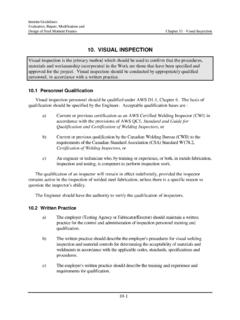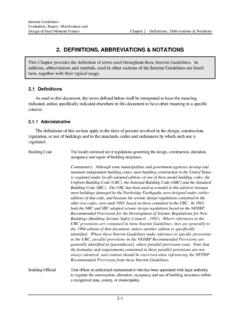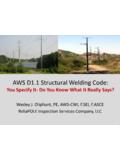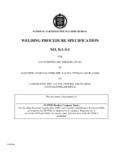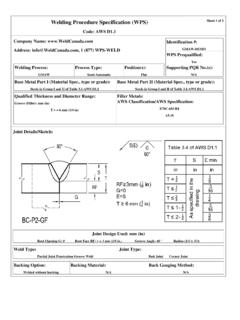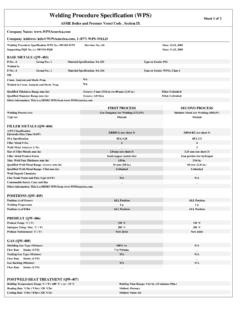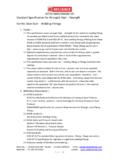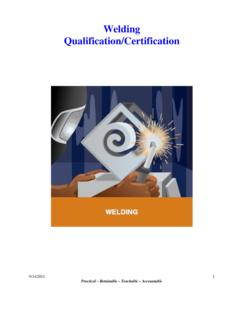Transcription of 8. METALLURGY & WELDING - SAC Steel
1 Interim Guidelines:Evaluation, Repair, Modification andDesign of Steel Moment FramesChapter 8 - METALLURGY & Welding8-18. METALLURGY & WELDINGS tandard industry specifications for construction materials and processes permit wide variation instrength, toughness and other properties that can be critical to structural performance. ThisChapter provides basic information on the variations in properties that occur, practical steps anengineer can take to control critical properties to acceptable levels of tolerance, and the specificinstances when such measures may be Parent SteelsDesigners should specify materials which are readily available for building construction and whichwill provide suitable ductility and weldability for seismic applications.
2 Structural steels which may beused in the lateral-force-resisting systems for structures designed for seismic resistance without specialqualification include those contained in Table 8-1. Refer to the applicable ASTM reference standardfor detailed 8-1 - Structural Steel Prequalified for Use in Seismic Lateral-Force-Resisting SystemsASTM SpecificationDescriptionASTM A36 Carbon Structural SteelASTM A283 Grade DLow and Intermediate Tensile Strength Carbon Steel PlatesASTM A500(Grades B & C)Cold-Formed Welded & Seamless Carbon Steel Structural Tubing in Rounds &ShapesASTM A501 Hot-Formed Welded & Seamless Carbon Steel Structural TubingASTM A572(Grades 42 & 50)High-Strength Low-Alloy Columbium-Vanadium Steels of Structural QualityASTM A588 High-Strength Low-Alloy Structural Steel (weathering Steel )
3 Structural steels which may be used in the lateral-force-resisting systems of structures designed forseismic resistance with special permission of the building official are those listed in Table 8-2. Steelmeeting these specifications has not been demonstrated to have adequate weldability or ductility forgeneral purpose application in seismic-force-resisting systems, although it may well possess suchcharacteristics. In order to demonstrate the acceptability of these materials for such use in WSMF construction it is recommended that connections be qualified by test, in accordance with the guidelinesof Chapter 7. The test specimens should be fabricated out of the Steel using those WELDING proceduresproposed for use in the actual Guidelines:Evaluation, Repair, Modification andChapter 8 - METALLURGY & WELDING Design of Steel Moment Frames8-2 Table 8-2 - Non-prequalified Structural SteelASTM SpecificationDescriptionASTM A242 High-Strength Low-Alloy Structural SteelASTM A709 Structural Steel for BridgesASTM A913 High-Strength Low-Alloy Steel Shapes of Structural Quality, Produced byQuenching & Self-Tempering ProcessCommentary.
4 Many WSMF structures designed in the last 10 years incorporatedASTM A36 Steel for the beams and ASTM A572 grade 50 Steel for the columns. This provided an economical way to design structures for the strong column -weak beam provisions contained in the building code. Recent studies conductedby the Structural Shape Producers Council (SSPC), however, indicate thatmaterial produced to the A36 specification has wide variation in strengthproperties with actual yield strengths that often exceed 50 ksi. This widevariation makes prediction of connection and frame behavior difficult. Somehave postulated that one of the contributing causes to damage experienced in theNorthridge Earthquake was inadvertent pairing of overly strong beams withaverage strength AISC and SSPC have been working for several years to develop a newspecification for structural Steel that would have both minimum and maximumyield values defined and provide for a margin between maximum yield andminimum ultimate tensile stress.
5 AISC recently submitted such a specification,for a material with 50 ksi specified yield strength, to ASTM for development intoa standard specification. It is anticipated that domestic mills will beginproducing structural shapes to this specification within a few years and thateventually, this new material will replace A36 as the standard structural materialfor incorporation into lateral-force-resisting certain circumstances it may be desirable to specify steels that are notrecognized under the UBC for use in lateral-force-resisting systems. Forinstance, ASTM A709 might be specified if the designer wanted to place limits ontoughness for fracture-critical applications.
6 In addition, designers may wish tobegin incorporating ASTM A913, Grade 65 Steel , as well as other higher strengthmaterials, into projects, in order to again be able to economically design forstrong column - weak beam conditions. Designers should be aware, however, thatthese alternative Steel materials may not be readily available. It is alsoimportant when using such non-prequalified Steel materials, that precautions betaken to ensure adequate weldability of the material and that it has sufficientductility to perform under the severe loadings produced by earthquakes. Thecyclic test program recommended by these Interim Guidelines for qualification ofconnection designs, by test, is believed to be an adequate approach to qualifyalternative Steel material for such use as well.
7 Interim Guidelines:Evaluation, Repair, Modification andDesign of Steel Moment FramesChapter 8 - METALLURGY & Welding8-3 Note that ASTM A709 Steel , although not listed in the building code asprequalified for use in lateral-force-resisting systems, actually meets all of therequirements for ASTM A36 and ASTM A572. Consequently, specialqualification of the use of this Steel should not be ChemistryASTM specifications define chemical requirements for each Steel . A chemical analysis is performedby the producer on each heat of Steel . End product analyses can also be specified on certain products. A certified mill test report is furnished to the customer with the material.
8 The designer should specifythat copies of the mill test reports be submitted for his/her conformance review. In general, ASTM specifications for structural steels include maximum limits on carbon, manganese, silicon, phosphorousand sulfur. Ranges and minimums are also limited on other elements in certain steels. Chromium,columbium, copper, molybdenum, nickel and vanadium may be added to enhance strength, toughness,weldability and corrosion resistance. These chemical requirements may vary with the specific productand shape within any given :Some concern has been expressed with respect to the movement inthe Steel producing industry of utilizing more recycled Steel in its processes.
9 Thisresults in added trace elements not limited by current specifications. Althoughthese have not been shown quantitatively to be detrimental to the performance ofwelding on the above steels, a new specification for structural Steel proposed byAISC does place more control on these trace elements. Mill test reports nowinclude elements not limited in some or all of the specifications. They includecopper, columbium, chromium, nickel, molybdenum, silicon and vanadium. Theanalysis and reporting of an expanded set of elements should be possible, andcould be beneficial in the preparation of WELDING procedure specifications (WPSs)by the WELDING engineer if critical WELDING parameters are required.
10 Modernspectrographs used by the mills are capable of automated analyses. Whenrequired by the engineer, a request for special supplemental requests should benoted in the contract Tensile/Elongation PropertiesMechanical property test specimens are taken from rolled shapes or plates at the rolling mill in themanner and location prescribed by ASTM A6 and ASTM A370. Table 8-3 gives the basic mechanicalrequirements for commonly used structural steels. Properties specified, and controlled by the mills, incurrent practice include minimum yield strength, ultimate tensile strength and minimum elongation. However, there can be considerable variability in the actual properties of Steel meeting , in cooperation with SEAOC, has collected statistical data on the strength characteristics oftwo grades (ASTM A36 and ASTM A572 Grade 50) of structural steels, based on mill test reportsfrom selected domestic producers for the 1992 production year.

